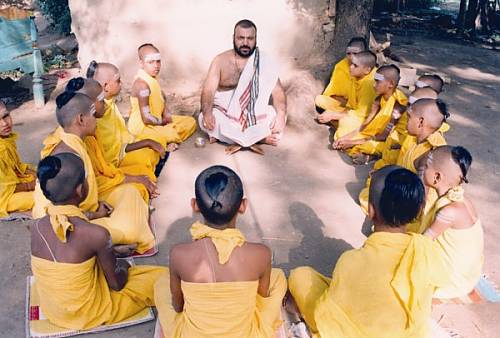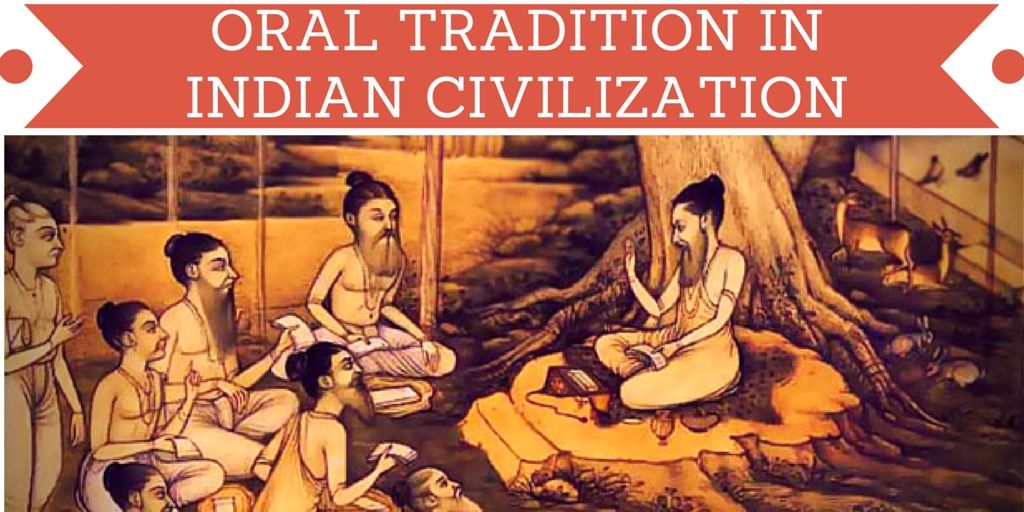In the celebrated Ramlila of Ramnagar, the whole village is transformed into a performance arena and becomes the venue where the divine lila is played out year after year during the festive season of Dussera. There are also several other versions of Ramlila from Chitrakoot, Agra and Delhi, which have carved their own niche in narrating the Rama story, as well as hundreds of neighborhood Ramlilas that happen in villages across north India. The fact that there is a Ramlila ground in almost every village, town and city in India testifies to the popularity of the performance of Ramlila in the country.

In contrast, the preservation of large portions of the Vedic corpus went on for centuries through a complex, highly codified method of transmission. Elaborate, highly sophisticated and foolproof mnemonic methods were used to instruct and memorize these compositions, which eliminated or decreased the danger of losing words, syllables or accent. The extraordinary effort of memorization emphasized correct pronunciation (akshara suddhi), correct duration of utterance (matra suddhi), and correct intonation of accents (svara suddhi). This oral tradition was kept incredibly fail-safe because it needed the intact safeguarding of a vast magnitude of verses. There were different recitational devices that helped to remember these texts. The basic step was padapatha, direct recitation of the Vedas splitting them word—by—word, combining with hand postures (mudra-s) to signify appropriate sound patterns, slowly graduating to the next level called krama where the first word of the mantra is added to the second, the second to the third and so on, until the whole verse is completed. This method enabled the student to know the individual words, and also combine words in recitation and the changes that occur in the sound that occur in the word as a result of the combination. While pada and krama are in the natural order of recitation, there are also indirect methods called vikrti which follow eight increasingly complex patterns of memorization such as jata, mala, sikha, rekha, dhvaja, danda, ratha and ghana. This elaborate system was developed with the purpose of preserving the purity of sound, word, pronunciation, intonation, pitch and sound combinations of the verses of the Veda and to facilitate the absorption of massive amounts of data as oral memory.
For preserving the chanting tradition in its utmost purity, texts called shiksha and pratishakhya explain the science teaching the method of pronunciation of vowels, alphabets. The siksha texts explicate the correct pronunciation of vowels (sound), while the pratishakhya texts focus on uniformity in utterance. The well-devised system of teaching-leaning Vedic transmission also had a functional (prayaga) aspect, which refers to its use in ritual. Vedic priests recited passages from the text which had diverse applications in rituals, rites. and sacrifices.
Accounts from early times including visiting travellers in ancient India like I-Tsing have given evidence to this system of oral memorization of texts. In the late nineteenth century George Buhler observed that a good Vedic oral practitioner of oral recitation knew massive amounts of textual material as memory and recall.
One of the most important critiques of the rote learning system in today’s educational theory is that it does not lead to the understanding of a subject or the acquisition of knowledge, but only to memorization, which is a mechanical process of repetition and retention rather than analysis. What then are the merits of this system practiced in India since time immemorial, that has now caught the attention of the world as a model worth emulation? The differential abilities of oral memory and writing are spelt out in the words of I-tsing. “Firstly, by repeatedly committing to memory, the intellect is developed; secondly, the alphabet fixes one’s ideas. By this way, after a practice often days or a month, a student feels his thoughts rise like a fountain, and can commit to memory whatever he has once heard. This is far from being a myth, for I myself have met such men.”
For the preservation and transmission of oral systems of transmission, audio/video techniques of documentation are useful. However, to prevent this multi-faceted knowledge from being erased from memory, we must revitalize the system from within. One way is to bring diverse aspects of our indigenous knowledge to “mainstream” academics, which since the colonial times has been marginalized as mere relics of the past. Linking indigenous knowledge effectively with education is the key to revitalize this knowledge.
Source: Indian Prespectives Magazine by Indian Diplomacy




Destroying the Shroutha (heard) and Smartha (remembered Brahmin traditions is what the British began after 1857,and their native stooges refined after 1921, but accomplished only in the last sixty years. They replaced the oral traditions whith haphazard and distorted books and the Brahmin law and guidance with a thousand cults.